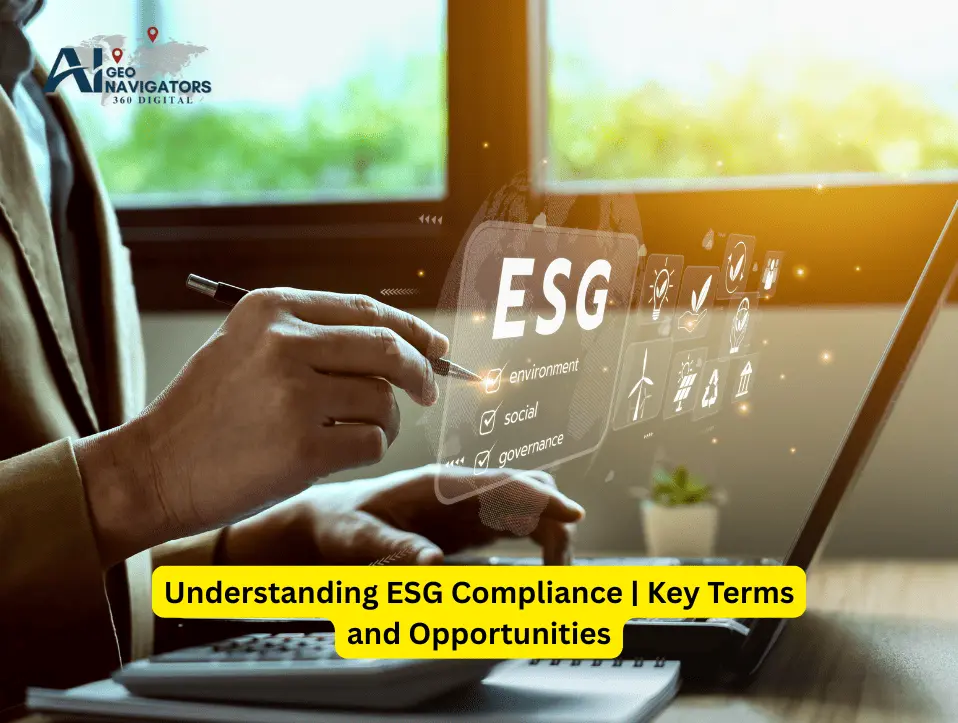Environmental, Social, and Governance (ESG) compliance has become one of the most important business priorities in recent years. Companies across industries are now being evaluated not only for their financial performance but also for how they manage environmental responsibilities, social impact, and governance structures. Investors, regulators, and consumers increasingly expect businesses to follow ESG frameworks and demonstrate accountability.
At AI Geo Navigators, we recognize that ESG compliance is not just a reporting exercise. It represents a shift in how businesses operate and how value is created in the long run. This blog explores the key terms that define ESG compliance, the risks of ignoring it, and the opportunities it creates for forward-thinking organizations.
What is ESG Compliance?
ESG compliance refers to a company’s ability to meet standards, regulations, and expectations related to environmental, social, and governance practices. It involves integrating sustainability into daily operations, risk management, and corporate decision-making.
- Environmental covers climate change, carbon footprint, resource use, energy efficiency, and biodiversity protection.
- Social includes labor practices, diversity and inclusion, human rights, and community impact.
- Governance focuses on corporate ethics, transparency, board diversity, and compliance with legal frameworks.
Compliance means following global frameworks like GRI (Global Reporting Initiative), SASB (Sustainability Accounting Standards Board), IFRS S1 & S2, and regulations introduced by local governments. Companies that embed ESG compliance build resilience and enhance their reputation.
Why ESG Compliance Matters in 2025 and Beyond
The push for ESG is driven by global megatrends — climate change, social justice movements, digital transformation, and corporate accountability. In Saudi Arabia, the UAE, and across the GCC, regulators are embedding ESG in corporate governance requirements aligned with Vision 2030 and sustainable finance frameworks.
For businesses, ESG compliance is no longer optional. Investors demand ESG reports before committing funds. Consumers prefer sustainable brands. Regulators enforce climate and labor laws. Companies that ignore ESG risk losing market share, funding opportunities, and trust.
At AI Geo Navigators, we see ESG compliance as a competitive differentiator. Companies that take it seriously are better prepared to attract investors, secure international contracts, and align with sustainable development goals (SDGs).
Key ESG Terms Businesses Should Know
To understand ESG, businesses must become familiar with common terms and frameworks. These concepts define how compliance is measured and communicated.
1. Carbon Footprint
A carbon footprint measures the total greenhouse gas emissions caused directly or indirectly by a company’s activities. This includes energy use, transportation, production, and even employee commuting. Companies track their carbon footprint to identify areas where emissions can be reduced.
2. Net Zero
Net zero means balancing the greenhouse gases a company emits with the same amount removed from the atmosphere. Many governments and businesses have pledged to achieve net zero emissions by 2050. Achieving this requires investing in renewable energy, energy efficiency, and carbon offset projects.
3. Circular Economy
The circular economy is about reducing waste and making the most of resources. Instead of a “take, make, dispose” model, companies reuse, recycle, and regenerate materials. For example, packaging made from recycled content contributes to circular economy practices.
4. Stakeholder Engagement
This term refers to involving all affected groups — employees, customers, investors, regulators, and communities — in sustainability planning. Companies that engage stakeholders are more likely to earn public trust and avoid social backlash.
5. Double Materiality
Double materiality means looking at sustainability in two ways: how issues like climate change impact the company, and how the company’s activities impact the environment and society. This principle is central to many global reporting frameworks.
6. Greenwashing
Greenwashing occurs when companies exaggerate or misrepresent their sustainability efforts. This damages reputation and can lead to regulatory penalties. Authentic ESG compliance avoids this by ensuring claims are supported by evidence and transparent reporting.
By mastering these terms, businesses can better understand investor demands and build ESG strategies rooted in credibility. At AI Geo Navigators, we help companies align with these concepts through clear, data-driven insights.
ESG Risks for Businesses
Ignoring ESG compliance exposes companies to risks that can threaten their reputation, finances, and long-term survival.
Regulatory Risks
Governments are tightening ESG regulations worldwide. In the Middle East, regulators are requiring sustainability disclosures as part of corporate reporting. Companies that fail to comply risk fines, reputational damage, or exclusion from government contracts.
Reputational Risks
Today’s consumers are more informed and socially conscious. A single case of environmental negligence or poor labor practices can damage a company’s brand permanently. Greenwashing, exaggerating sustainability claims also leads to backlash.
Financial Risks
Banks and investors increasingly use ESG ratings when making decisions. Non-compliant companies face higher borrowing costs or may be denied access to capital markets. With sustainable finance gaining momentum, companies that lack ESG credentials are left behind.
Operational Risks
Climate change introduces operational disruptions such as floods, heatwaves, and supply chain breakdowns. Companies that do not integrate ESG into planning are more vulnerable to these shocks.
Talent Risks
Employees today want to work for purpose-driven organizations. Companies with weak ESG practices may struggle to recruit and retain top talent, especially among younger generations.
At AI Geo Navigators, we work with companies to map out ESG risks using geospatial tools. By analyzing vulnerabilities in supply chains, environmental exposure, and governance gaps, we help businesses mitigate risks before they escalate.
ESG Opportunities for Forward-Looking Companies
While the risks are significant, the opportunities created by ESG compliance are even greater.
Access to Green Finance
Banks and investors are allocating trillions toward sustainable finance. ESG-compliant companies can tap into climate funds, concessional loans, and green bonds. This creates a competitive edge in capital markets.
Competitive Advantage
Strong ESG credentials build trust with consumers, regulators, and partners. Companies that lead in ESG are more attractive to global clients who want sustainable supply chains.
Cost Savings
Sustainability often leads to efficiency. For example, energy-efficient systems reduce electricity bills. Waste reduction lowers disposal costs. Over time, ESG practices save money.
Innovation and New Markets
ESG pushes companies to innovate. Businesses develop low-carbon products, sustainable packaging, and inclusive services that meet new market demands.
Stakeholder Relationships
Transparent ESG compliance builds stronger relationships with governments, employees, and communities. This creates resilience and long-term stability.
At AI Geo Navigators, we see ESG as a growth strategy. Our geospatial and AI-driven solutions help companies find opportunities in environmental monitoring, social inclusion, and governance improvement.
ESG and Technology Integration
Technology has become the backbone of ESG compliance. It enables accurate measurement, monitoring, and reporting of sustainability performance.
- GIS and Remote Sensing allow companies to track deforestation, water usage, land degradation, and carbon emissions.
- AI and Machine Learning analyze data patterns, automate reporting, and forecast climate risks.
- IoT Sensors monitor real-time energy use, emissions, and safety compliance.
- Blockchain increases transparency in supply chains, ensuring ethical sourcing of materials.
- Cloud Platforms centralize ESG data for reporting and audits.
At AI Geo Navigators, we specialize in combining these technologies with ESG reporting. By integrating geospatial data with sustainability frameworks, we help organizations comply with regulations while also improving performance.
Steps Toward ESG Compliance
Companies often ask: where should we begin? Here are five steps to start the ESG journey:
- Assess Material Issues – Identify which ESG issues matter most for your industry and stakeholders.
- Set Measurable Goals – Define clear targets, such as emission reductions or diversity ratios.
- Adopt Global Frameworks – Align with standards like GRI, SASB, or IFRS.
- Leverage Technology – Use GIS, AI, and IoT for monitoring and reporting.
- Engage Stakeholders – Build trust by involving employees, investors, and communities.
AI Geo Navigators helps organizations through each stage of this journey, ensuring compliance is not just a requirement but a source of value creation.
Conclusion
ESG compliance is no longer optional, it is the standard for modern business success. Companies that ignore it face financial, reputational, and operational risks. Those that embrace it gain access to green finance, innovation opportunities, and competitive advantages.
At AI Geo Navigators, we see ESG as an opportunity to combine technology, sustainability, and governance for long-term impact. By integrating geospatial analytics, AI, and ESG frameworks, we help organizations measure progress, reduce risks, and unlock opportunities.
The future belongs to companies that act now. ESG compliance is not just about reporting, it’s about building resilient, responsible, and future-ready businesses.


No responses yet